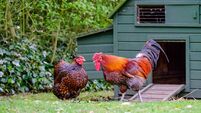Experts warn of the risk of costly mould on silage bales
With 12 million big bales of silage made each year on more than 80% of all farms, the Teagasc survey indicates that the equivalent of 700,000 bales have mouldy surfaces.
Teagasc researchers say the threat is wasted silage rather than any immediate fear of poisoning livestock. However, some moulds can produce potentially harmful toxins, the effect of which on animal health is not fully understood.
Mould usually occurs due to air getting in through thin, damaged or punctured plastic warp.
Half of the bales inspected had visible damage to the plastic film.
Mould growth on bales will usually do damage between November and March so damaged bales should be fed first.
The samples were taken from farms in six regions of the country.
Bales on farms in the north midlands and the south east were found to have the least amount of mould.
For higher baled silage quality, Teagasc says bales should be transported to the storage area before being wrapped.
Wrapping should be carried out immediately after baling, using at least four wraps of good quality plastic at the correct tension.
Storage on a smooth surface is also important, as is protection of the bales from birds and from cats by using a fine mesh net two feet above the bales.













